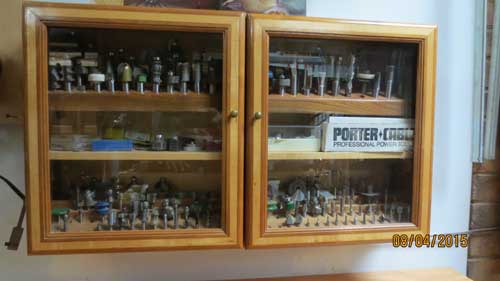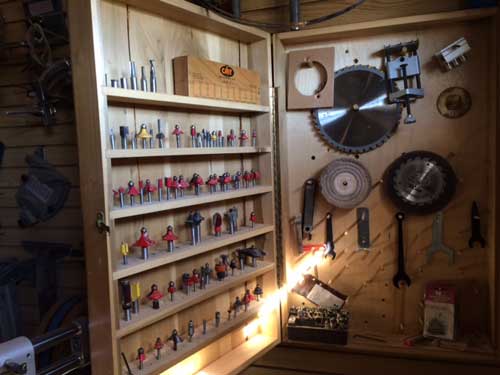
In last issue’s eZine editorial, Rob asked for advice about router bit storage. For one reader, this subject brought forth a tale of woe. – Editor
“Hmm, when you figure out what to do, share it with me. I have/had a set of RYOBI bits (my primary go-to set) that I have been unable to find for nearly six months. It started when I did away with a commercially made for the consumer Craftsman table and built a much larger table. In this transition, I have misplaced them. Maybe I threw them in the garbage by accident during my after-the-project cleanup. I sure would like to know. If I have to buy another set, I may have to hide the purchase from my wife! I hate doing that. Anyways, thanks for the article. Now I am sad because I had forgotten about losing them until I read your article.” – Kevin Hanes
Fortunately, some readers have come up with some storage solutions that actually seem to be working for them. – Editor
“First, you build a router table cabinet with lots of drawers. Then, line each of the narrow drawers with pieces of that semi-rigid foam insulation that computers and such come packed in. With cork borers or similar sharpened tubing, cut either 1/2″ or 1/4″ holes through the foam, spaced appropriately. Voila: protected, readily accessible and identifiable router bits! I hate to admit it, but all six of the center small drawers are filled thusly with bits.” – Gary McKown (Editor’s Note: See Gary’s drawer at the top of this Feedback page.)
“The bits that I have were sold in heavy-duty, clear plastic sleeves, with all pertinent information printed on the sleeve. And because they’re usually sold on a pegged rack, there’s a hanger hole at the top of the sleeve. Following the lead of the manufacturers and sellers, I store my bits in their original sleeves on pegboard with hooks. Enough with reinventing the wheel!” – John Hutchinson
“I probably don’t have as many bits as you do, but this is what I use.” – Marv Enerson
Some use ready-made (albeit repurposed) storage boxes. – Editor
“I went to Academy Sports and purchased a large four-drawered fishing container, 12hx18wx12d. Each drawer has a lid and variable width ‘cells.’ It has a handle to carry from place to place. One of the drawers is for 1/4″ bits. Two drawers are for 1/2″ bits and one drawer is for the ‘nuts and bolts’ of the accessories that I have for my routers (yes, Virginia, I also have multiple routers … set up for specific uses). The centralized container for the nuts and bolts includes spacers for bits, screws for the fence, metal rods for the fence, a bit of wax in a sealable plastic bag (this is Texas) and a brass and steel brush for immediate cleaning if necessary along with some light oil. I have found that this ‘kit’ is almost essential because I don’t have to wonder where that 1/4 by 20 thread screw is located. In other words, I can’t live without the box of bits. When the box is being used, I turn it on its side so the drawers will slide out. Each drawer has a gravity lock to prevent the drawers from sliding out. When I am done for the day, I put the box on its backside with the handle up and all is protected from dust, droplets, and debris. I have been known to use a small 1-1/2′ square piece of cloth for those bits that are vulnerable to extreme elements.”- Jim Parks
“I went to a sports shop and got cartridge holder boxes. They come in different sizes and colors. 1/4 one color, 1/2 another color. Works for me!” – Robert Butler
“I use a CMT bit organizer tray – half of it set up for 1/2” bits and the other half set up for 1/4” bits. Originally the tray held all of my bits, but I seem to have a ‘rabbit collection’ that multiplies even when I am not shopping. Now only the key bits that I use more often are stored on the tray. I have three homemade trays: one for 1/2” profiling bits and one each for the bits for my Rockler and Leigh dovetaijigs. Sounds organized but trust me, it is still a mess hidden in my router table cabinet.” – Gary Cawn
And some seem to use this storage dilemma as an excuse … er, reason … to create another project in the shop. – Editor
 “I built a cabinet with glass doors to hold most of my bits. Have never counted them, but quite a few. I have other sets, but they are in the small storage boxes that were usually supplied with the bits. The cabinet is 16″ x 28″ x 6″ and has three shelves, one dedicated to 1/2″ bits, one to 1/4″ bits and one for collars, bearings, collets, etc. The shelves are sloped and stair stepped to allow easy spotting of the bit I need through the glass doors. I ran into the dilemma of storage of router bits many years ago and this is my solution.” – Dave Arnold
“I built a cabinet with glass doors to hold most of my bits. Have never counted them, but quite a few. I have other sets, but they are in the small storage boxes that were usually supplied with the bits. The cabinet is 16″ x 28″ x 6″ and has three shelves, one dedicated to 1/2″ bits, one to 1/4″ bits and one for collars, bearings, collets, etc. The shelves are sloped and stair stepped to allow easy spotting of the bit I need through the glass doors. I ran into the dilemma of storage of router bits many years ago and this is my solution.” – Dave Arnold
“ Your question was, ‘How do you store your router bits?’ Two years ago I went one bit further and asked, ‘How do you store your router bits AND FIND THEM?’ Each drawer bottom is 3/4-inch black melamine surfaced plywood. Using my milling machine, I drilled holes for each size of bit and numbered each hole. I then made a list of all bits and rearranged the order so they could each be numbered. The local art supply store had a number of permanent markers (for artists) and I chose three for various situations (not all router bit shafts are the same color or size). Each bit was numbered and then inserted into the assigned numbered hole. Some of the holes are blocked by larger bits, but that’s OK – the extra space keeps you from dinging up your fingers on the sharp edges.What’s also good about the system is that invariably I have several bits out of the cabinet at the same time. This system allows me to identify each one so that I don’t inadvertently use the wrong bit, and helps to get every thing back in its place. It’s handy, takes up little space, and facilitates even using long router (milling) bits in the same system.” – John Dorchester






